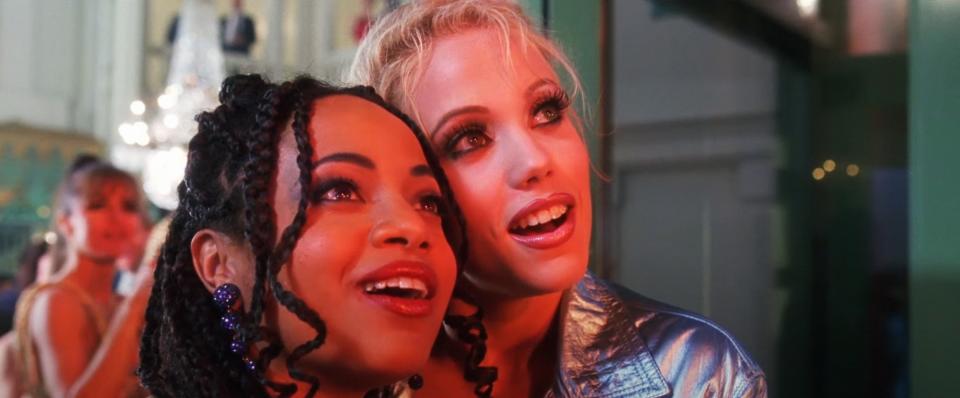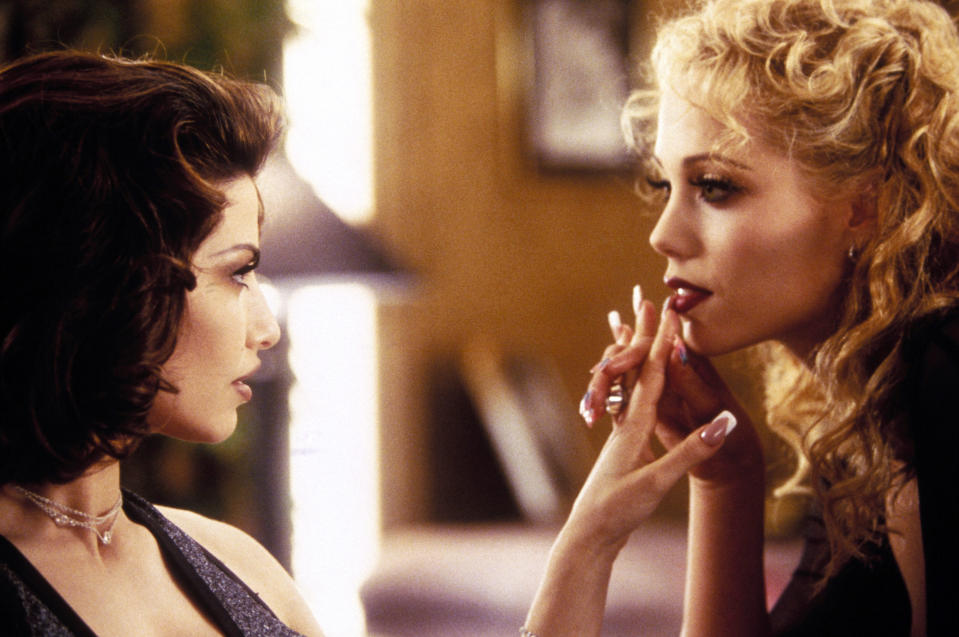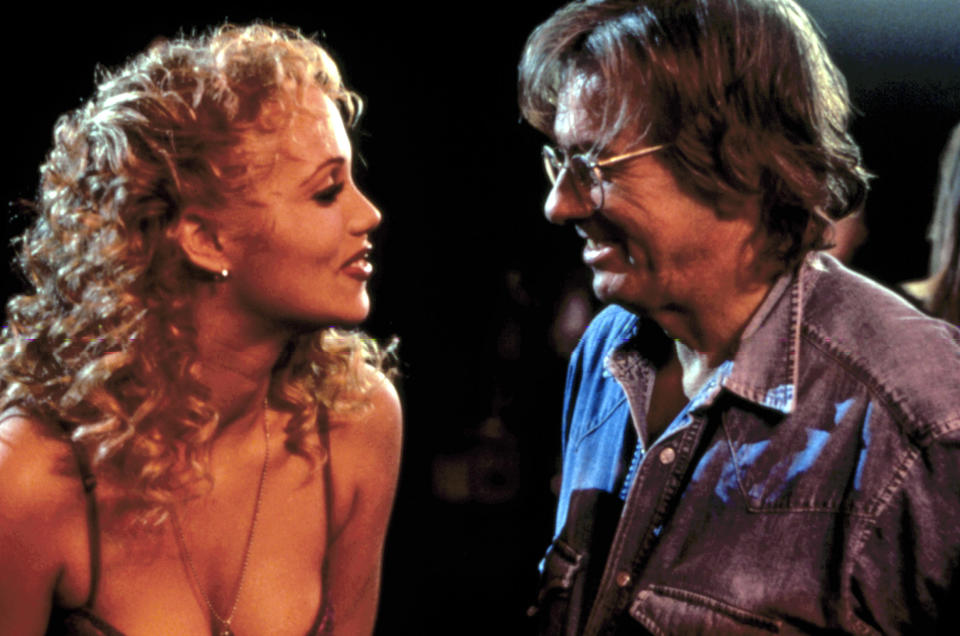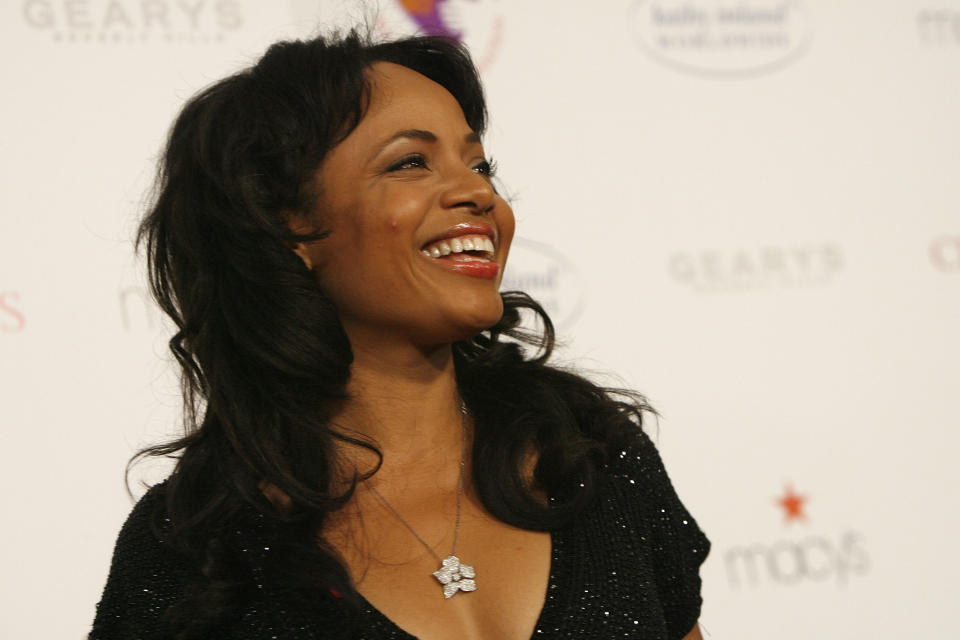'Showgirls' at 25: Star Gina Ravera discusses the cult movie's most controversial scene
Watch: The director’s reel from Director Paul Verhoeven below
When it danced into US cinemas on 22 September, 1995, Showgirls represented a calculated career risk for director Paul Verhoeven, star Elizabeth Berkley and Hollywood in general.
For the first time, a mainstream studio movie planned to test the boundaries of the MPAA’s newly created NC-17 rating, promising moviegoers in-your-face sexuality, copious nudity and over-the-top melodrama at the multiplex. Written by Joe Eszterhas — who previously collaborated with Verhoeven on the envelope-pushing 1992 hit Basic Instinct — Showgirls attempted to distill the seedy glamour of Las Vegas into film form, telling the story of aspiring showgirl Nomi (Berkley), who proves herself ruthless in the pursuit of fame, fortune and power.
In the end, the film was a risk that didn’t pay off for anyone involved: Soundly rejected by critics, audiences and the industry alike, the failure of Showgirls slammed the door on other commercial filmmakers interested in pursuing the NC-17 rating as a creative option. Even now, 25 years after its premiere, no major Hollywood studio has opened an American-made NC-17 feature film in wide release, opting instead to either re-edit the movie to receive an R rating or release an “unrated” cut for limited theatrical runs and home entertainment releases.

Despite the vitriol it inspired at the time, Showgirls has had the last laugh. A quarter-century later, Verhoeven’s movie is a certified camp classic, one that’s regularly shown at midnight movie revivals and drag show performances … albeit back in the pre-pandemic times when fans could attend those kinds of events in person. In a 2016 interview with Yahoo Entertainment, the director seemed alternately bemused and baffled by the film’s afterlife.
“I don’t think that I went out of my way to make a camp movie,” Verhoeven remarked. “I think what I was trying to do with all the people around me, cast and crew, was to make a movie that was in all aspects completely hyperbolic. We wanted to push it and push it, as Vegas is something where everything is over the top. I’m not so sure that was a good idea.” (Watch our full Director’s Reel with Verhoeven above.)
Read more: Showgirls: Piece Of Trash Or Ironic Masterpiece?
Showgirls co-star Gina Ravera is also hesitant to fully embrace the film’s camp status, for more personal reasons. As Molly Abrams, the good-hearted costume designer that Nomi befriends soon after blowing into town, the actress plays the one character in Showgirls’s heightened version of Las Vegas who doesn’t have a darker agenda.
“She’s very sweet, and there’s no hint of darkness,” Ravera tells Yahoo Entertainment in her very first interview about the film since its release. Because of her inherent goodness, Molly is also offered up as the movie’s “sacrificial lamb,” brutally beaten and abused in a traumatic rape sequence that’s difficult to watch, even for the movie’s most die-hard fans. That controversial scene was even harder for Ravera to perform. “When you do a scene like that, your body doesn’t know it’s not real,” she says now, characterising the filming of that sequence as a deeply unpleasant and painful nine-hour ordeal. “I don’t know if I would have taken the movie if I had understood that.”

To this day, Ravera has only seen Showgirls once — at the film’s 1995 Los Angeles premiere — and she purposely left during the rape scene. “I know I didn’t want to see that for any reason,” she says, emphatically. Even as the film became embraced as a cult favourite, she’s purposely remained on the sidelines, declining to appear at public events or even discuss her experience in the press until now.
That’s a contrast from Verhoeven and some of the other cast members, including Berkley, who has been more public about embracing the movie’s camp status. In 2015, the Saved By the Bell star (who will headline a reboot of the series that will premiere on new US streaming service Peacock later this year) introduced a 20th-anniversary screening of Showgirls in Hollywood, and described the experience as a “magical full-circle moment.”
And in a 2017 interview with Yahoo Entertainment, co-star Gina Gershon said she was “super-happy” the movie had a latter-day fanbase, but also expressed ambivalence about revisiting it.
Ravera understands those feelings. “It’s tough to talk about,” she explains. “It was a complicated movie, and I had a different path on the film than other people did. It’s really a heavily cynical dark satire, and the filming of it had all of that darkness in it. People want to just call it camp, but it isn’t camp. There’s too much darkness in it to avoid all of the weight.”
At the same time, the actress makes it clear that her time on the Showgirls set wasn’t entirely defined by darkness, speaking joyfully of wild nights out in Reno with the film’s large cast of dancers and the pleasures of watching talented artists like choreographer Marguerite Derricks put the performers through their paces. She also relished the chance to work with Verhoeven; growing up as a young San Francisco cinephile, she saw the director’s Dutch films like Soldier of Orange and Spetters at her local art house in the Castro and enjoyed his run of wryly satirical Hollywood blockbusters that began with 1987’s RoboCop.
Read more: Charlize Theron Auditioned For Showgirls, 'Didn't Mind All The Nudity'
Verhoeven’s involvement was ultimately the reason why Ravera decided to audition for Showgirls after her agent passed along Eszterhas’s script in 1994, when she was still working as a classically trained dancer while pursuing an acting career. “I read the script, but I didn’t know what the movie was — I couldn’t make it out,” she remembers. “I thought it was going to be the drama of Basic Instinct and the dark world of Las Vegas, but everything was pitched so high in terms of dialogue that I couldn’t put my thumb on it. But I was like, ‘Oh, my God, it’s Paul Verhoeven! Who cares if I don’t understand what this movie is about? He’s smart!’”

Interestingly, Ravera was supposed to audition for the role of Nomi’s nemesis (and love interest), Crystal, who Gershon ended up playing. But even that early in her career, the Afro-Latina actress was all too aware of the casting limitations facing performers of colour. “I knew there was no way they were going to cast me as Crystal,” she says, frankly. “The studio wouldn’t have done it. At that point, you saw very few Black or Latin women getting the leads in films, and I didn’t want to learn all that material for something I knew was a no-go.”
Instead, Ravera told the casting director that she would read for the part of Molly, although she was keenly aware that the “Black best friend” role played into a long-standing Hollywood stereotype. “It’s the Hattie McDaniel role, where you take care of the needs of the white woman, and you don’t have a storyline of your own. It was a difficult decision for me, but it was also one of the first movies I was ever going to do. A lot of Black girls have to do that job, and I had to start somewhere.”
Ravera credits Verhoeven with recognising that she was accepting a largely thankless role and giving her room to make the part her own. “He promised me that he understood that it was very complicated being a Black woman in Hollywood, and that I wasn’t going to be given the same opportunities as that of a white counterpart. I had never felt seen by a director like that. He’s a European, so he’s able to look at America through a different lens. He doesn’t have the same investment in the idea that everything was equal for all.”
If Eszterhas’s script didn’t make it clear what kind of movie Showgirls would be, working with Verhoeven on set helped bring the tone into focus. “Every scene that I shot with Elizabeth, he would act out with us,” she remembers. “He was very specific in what he wanted, and that’s when I started to realise what he was going for.” Even so, she admits that something crucial got lost in translation. “He had so many styles going on simultaneously — it was like too many types of pepper,” Ravera explains with a laugh. “You got white pepper, chili pepper, cayenne. It’s going to be too hot! The wardrobe was big, the makeup was huge, the acting was huge and the drive of the Nomi character was huge. It’s all hyperbolic, and I think it’s set at such a high level you couldn’t perceive the subtlety of what he was trying to say about the quest for stardom and how fame is monstrous. He could have brought in some other hues so he could highlight specific elements about the culture that he was trying to communicate to the audience. Unfortunately, it was all bright and loud.”

While that style may encapsulate Las Vegas, as Verhoeven says he intended, it also explains why many moviegoers at the time rejected the film’s garish, cranked-up-to-11 portrait of Sin City. The director, along with the cast and crew, got a first taste of the public fury to come at the movie’s premiere.
“The premiere was rough,” Ravera remembers. “People were walking out. I could see the shock in Paul’s eyes: He had no idea that they wouldn’t understand what he was trying to say. I felt for him. He had a very specific vision he wanted to bring to the screen commenting on stardom, Hollywood, Las Vegas, greed and ambition. That hyperbolic style that he mentions often in interviews was what he was trying to achieve.”
Ravera also blames some of the negative reaction on the hoopla surrounding the NC-17 rating and the presence of a former teen star like Berkley playing a distinctly adult role. “America’s very conservative; I was a European film watcher, and I knew sexuality isn’t the taboo subject over there that it is in this country. So I understood that as soon as they saw breasts, there’s going to be an uproar. We’re OK shooting each other, but not making love to each other.”

Although Molly isn’t a showgirl like Crystal and Nomi, Eszterhas’s original script did feature several scenes of casual nudity where she doffs her top, including a shower sequence that Ravera declined to film. “I think I said, ‘What do you need my tits for? You’ve got everyone else’s!’” she laughs. But her choice to forgo nudity also generated tension between her and Verhoeven that came to a head in the aforementioned rape sequence. In the film, Molly arrives at a party thrown in Nomi’s honour and meets her longtime crush, Vegas singing sensation Andrew Carver (played by Verhoeven regular William Shockley). Carver escorts Molly to a private room, where he beats her and then enlists his bodyguards to pin her down while she screams and cries.
It’s the point in the movie where the violence that’s run underneath the narrative explodes to the surface in bloody, brutal fashion. “I took the rape scene very seriously, because when you see rape on film, you know you’re representing people who have lived through it,” Ravera says, adding that she thought a lot about the 1988 film The Accused, which starred Jodie Foster as a rape survivor. “I thought, ‘I’m going to do this scene so the girl who goes to that party and gets asked to that room doesn’t go into it.’ I was willing to do the scene for that person, because this is a real moment in the world, unfortunately. Women are victims of this violence.”
Reflecting on the sequence 25 years later, Ravera indicates that Verhoeven could and should have done more to prepare her for how he planned to direct her and the other actors. “He wanted it to be more realistic; this character is good in a dark world, so he needed it to be brutal. I wish he had told that to me; I wish he had said, ‘This is the reason for the brutality.’” According to Ravera, Verhoeven’s pursuit of realism led him to be “very exuberant” in his directions to her male co-stars, which in turn encouraged them to be “overzealous” in their performances when the cameras were rolling.
“[Paul] was like ‘Closer, closer’” she remembers him saying to Shockley. That resulted in Shockley striking Ravera on camera. “The [punch] you see in the film made contact. My jaw was not right for years. It can go too far, [and] it went too far.
“There was no acknowledgment of what it was going to be, and I didn’t know what to ask for because I’d never been in a situation like that in real life nor professionally. It was my first [rape] scene. There’s no one to call and say, ‘How’d you do that rape scene?’ And, you know, you’ve got two men holding you down; my wrists were bruised, and my body was just covered in bruises after it because of what was asked for the camera. It’s like a stunt, and people get hurt in stunts. But you know what you’re signing up for [with stunts], and I didn’t know.” Since then, Ravera has made a point of turning down roles that would require her to play a victim of sexual abuse.
“I don’t like being known for that, or knowing that my image is on the internet in perpetuity in a rape scene. That was the last time I ever played a woman who has gotten hit or was vandalised. It cost me a few jobs too.” [Yahoo Entertainment reached out to Verhoeven for comment, but the director could not be reached at press time.]
Beyond her experience performing that scene as an actress, Ravera says that she’s still disturbed by what it meant for Molly, who is last glimpsed barely conscious in a hospital bed after Nomi has taken revenge against Carver for his crime. “You’re just brutalising this character; you tear the character apart and you don’t do anything with it — she just sits there broken,” she notes. “That I still have a problem with. We’re watching a Black girl be completely gutted for no reason except to have this character [Nomi] vindicated, because she has no redeeming qualities whatsoever. I’ve never been happy about it, because the movie didn’t need it. When you give that kind of work as an actor, I think you want to know it has some value. If I was the editor, that would have been clipped. We’d have to find another event to show that Nomi has a heart; something that’s not so dark.”
Asked what she thinks happens to Molly after the film ends, Ravera says she believes that her alter ego recovered and promptly left Las Vegas. “If we follow the rules of Showgirls, which is that Las Vegas is a place where only the darkest and greediest survive, then it’s not a world for someone like Molly. She would have to go home. The film treats it as, ‘That’s what happens to good people in this industry,’ and it’s actually kind of true.”

In real life, though, Ravera hasn’t gone anywhere. Since Showgirls, she’s appeared in successful mainstream hits like Kiss the Girls and Soul Food, where she says she invested a little bit of Nomi into her character, Faith. “She was someone who had been abandoned by her family and had no mother and no guidance. I thought a lot about Showgirls in terms of what it means to be that lost and that broken.”
Ravera also had a regular role on the popular police procedural The Closer, and during the making of the series she remembers attending an LAPD event for rape survivors and speaking with several women who were deeply affected by the rape scene in Showgirls. “They were like, ‘That was horrible,’” she says. “Another woman asked, ‘What was it like shooting that?’ I told them, ‘I was messed up for a little while.’”
That’s why she’s made a conscious choice not to revisit the film, even in the context of a celebratory event like a 25th-anniversary revival where fans come dressed in costume and act out scenes. “What you’re seeing is the byproduct: I remember the moments of filming it, and the people and what was said. So it’s mixed; there’s some good stuff. I wish I could see it the way other people do — I wish I could.”
Showgirls is currently streaming on MUBI.

 Yahoo Movies
Yahoo Movies 

